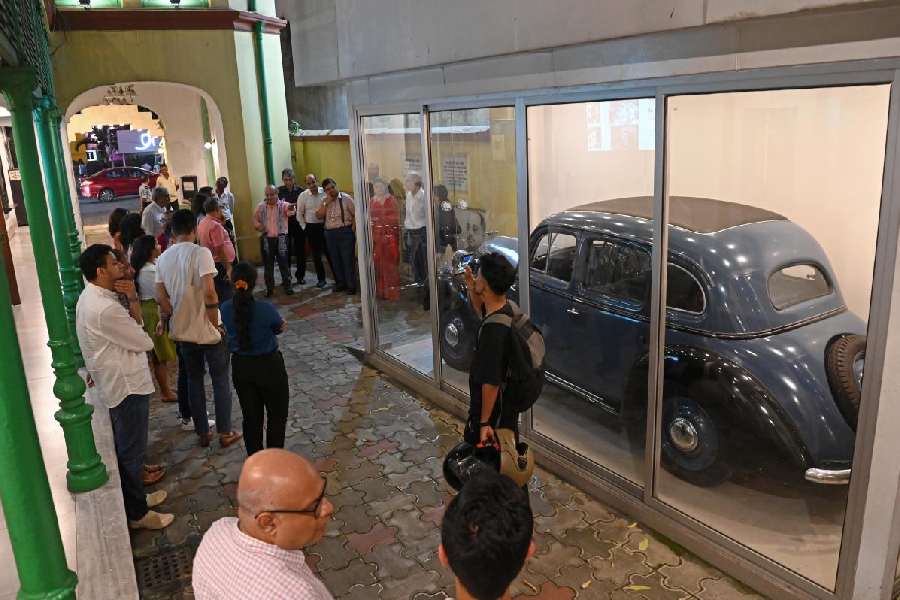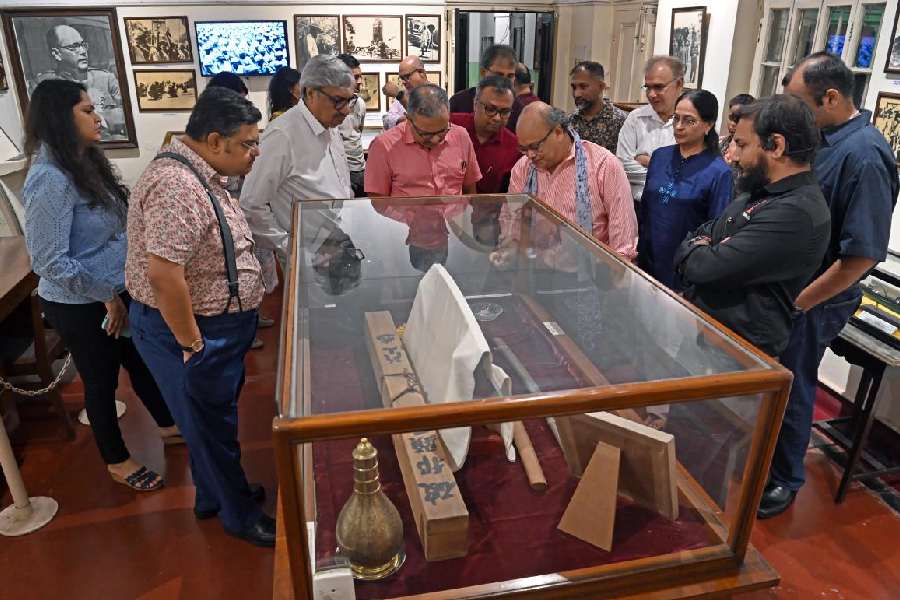- The handwritten resignation letter of Netaji from the Indian Civil Service, dated April 22, 1921.
- A terrace above the central portico at Netaji Bhawan which provides a view of the entire house has a 1937 photograph of Netaji sitting on a chair on the same terrace, with a copy of the Hindustan Standard, an English daily that the Anandabazar Group used to publish, on his lap.
A group at Netaji Bhawan was amazed by the historic building and the stories inside.
The group, alumni of the London School of Economics (LSE) from the mid-90s to those who will graduate in 2024, were provided a guided tour by Sumantra Bose, the grand nephew of Netaji Subhas Chandra Bose on October 1.
It was the annual event of the LSE called Welcome to the City. Also present, were members of the Indo-British Scholars’ Association (IBSA), the umbrella body for all UK alumni.
“The LSE directs its alumni to host such an event in each city to welcome fresh graduates so they interact with alumni. It gives them an opportunity for mentorship and career guidance,” said Nayantara Palchoudhuri, alumni leader, LSE, and past president of the IBSA.
Bose, an author, political scientist and professor at the LSE, made the visit anecdotal, enriching and informative.
Bose is the son of Sisir Kumar Bose, a freedom fighter who at the age of 20 had helped his uncle Subhas Chandra Bose escape from the 38/2 Elgin Road house, now Netaji Bhawan.
“That escape started at 1.35am from the room upstairs.... That escape was the beginning of Subhas Chandra Bose’s journey to becoming Netaji,” Bose said before starting the hour-long museum tour.
The walk started with the group congregating in front of the iconic Wanderer car in which Netaji had fled house arrest in 1941.

The Wanderer car, in which Netaji had fled house arrest in 1941, on display at the museum.
The car is taken out of its enclosure every Monday and driven on the premises, Bose shared with his audience.
“My father owned the car but he donated it to the Netaji Research Bureau’s museum,” Bose said.
The Netaji Research Bureau was established in 1958 and the Netaji Museum was started by Sisir Kumar Bose in 1961.
The house on 38/2 Elgin Road was built in 1909-10. Netaji, born in Cuttack, came to live in this house only at 16.
Bose said that after WWII ended in 1945, Sarat Chandra Bose (Netaji’s brother), decided that the house should no longer be used for private residential purposes and should be dedicated to the nation and named in honour of his legendary brother.
“Sarat Chandra Bose gave this house its name, Netaji Bhawan, in 1946-47, just before Independence. Sarat Chandra Bose envisioned that Netaji Bhawan would do two things — be a living memorial, not just a house... and be a place of national pilgrimage for Indians of all faith, linguistic backgrounds, regions, communities,” said Bose.
But Sarat Chandra Bose died prematurely in 1950 and so some years after his death, his son, Sisir Kumar Bose, decided to establish an organisation called the Netaji Research Bureau.

The LSE alumni group sees exhibits at the museum.
“My father, having played his part in the freedom struggle, decided to establish an organisation called the Netaji Research Bureau... to realise his father Sarat Bose’s vision, to document Netaji’s vast life which is all over the world, not just in the subcontinent but across Europe and Southeast Asia,” said Bose, the director of the bureau since 2020.
The youngest of the alumni, who has completed her course and will graduate in December, Pranati Mal, felt it was an “insightful experience”.
Palchoudhuri said the visit was more memorable because “the anecdotes were shared by a descendant of the family”.











